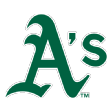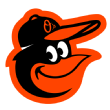The middle tier from my preliminary forecasts is comprised of those teams that currently rank Nos. 20 to 11 (we're counting down) in projected run differential.
Many of the teams in this group have similar ranges of possibility, in that six months from now, you wouldn't be very surprised to see them in contention. Some of them could slip into rebuild mode, and others could become top-tier contenders if offseason problems are solved in an affirmative manner.
 Oakland Athletics: How low can you go?
Oakland Athletics: How low can you go?
It feels like the A's have been in limbo forever. There's been talk of the Athletics abandoning Oakland on and off since the 1970s, when Charlie Finley threatened to move the club to Denver or New Orleans.
And yet as we enter the 2017 season, the A's still play in what we used to call Oakland-Alameda County Coliseum, the only home they've had since abandoning Kansas City -- and the short walk to get Arthur Bryant's barbecue -- in the late 1960s.
Poor Billy Beane has been lionized, fictionalized and marginalized seemingly several times over, and here he still is, trying to piece together a team on a shoestring budget in hopes that, someday, his club will attain equal revenue footing with other teams. Although Beane's roster management this winter was a bit yawn-inducing, we're likely to look back at this offseason as the moment when the A's finally started to escape their longtime quagmire.
First there was an ownership shakeup, as John Fisher takes over for Lew Wolff as managing partner. He hasn't said much, but incoming team president Dave Kaval told the media that the franchise is committed to pulling off a privately funded ballpark in Oakland. You could dismiss that as rhetoric, but not long after, when the players and owners reached an agreement on a new CBA, we found out that the A's would be dropped as a revenue-sharing recipient. That process will be phased in over a four-year period.
The end result is that, at last, something's gotta give. The A's either need to start generating their own revenue with a new facility, find a new city or stay put and field $12 million payrolls. (That's an exaggeration, but you get the point.)
Meanwhile, Beane has a club with a lot unfamiliar names but with a makeup that will seem familiar. The starting pitching could be a strength if Sonny Gray bounces back and the young guys behind him do what other young Oakland rotations have done in the past. Sean Manaea was terrific as a rookie, and he'll be joined by Jharel Cotton, Kendall Graveman and, perhaps, Andrew Triggs in the promising group.
Beane pieced together a veteran-laden bullpen that includes Santiago Casilla, Sean Doolittle (no relation of which I'm aware to the author), John Axford and Ryan Madson. The set of position players is a bit out of step with the leaguewide trend toward athleticism.
Like A's teams of yore, the offense will try to draw enough walks and hit enough homers to offset what seems likely to be the majors' worst defense.
 Baltimore Orioles: A winter of contentment
Baltimore Orioles: A winter of contentment
With just a couple weeks to go before pitchers and catchers report, the Orioles' offseason work looks pretty modest. Catcher Matt Wieters left as a free agent (though he's still unsigned as of this writing).
After a few weeks of limbo, slugger Mark Trumbo was retained on a three-year deal. Fading starter Yovani Gallardo was shipped to Seattle for Seth Smith, who'll get a lot of at-bats against righties as part of a corner position/DH mix. Bat-first catcher Welington Castillo was inked to replace Wieters. That's about it.
Baltimore has finished .500 or better for five years running under Buck Showalter and has made the postseason three times, a run of success not seen by the Orioles since the late 1990s. The O's feature one of the five best players in the game in Manny Machado and a superstar closer in Zach Britton. Could anyone really blame GM Dan Duquette for playing it safe-ish?
Let's start with this: The Orioles' 89 wins last season were about five more than you would've expected based on their run differential. The most likely explanation for that, beyond good fortune, was the Britton-led bullpen, which still looks strong. But it's a bullpen with its year-to-year variability built in, and it will again be asked to prop a rotation that is at best middling and at worst terribly thin.
If you buy into run differential as a forward-spinning indicator, and the Orioles' 2016 true talent level was more like 84 wins, then you would have expected more aggressive moves this winter. It might be different if there were a number of ascending players for regular roles. If there are, I'm not seeing them. Nor is there likely to be an impact player coming up from the Baltimore system in the near-term.
The Orioles' timeline looks fixed. Machado and Britton are both scheduled to hit free agency after the 2018 season, as will Adam Jones, who by then might not be a viable defensive center fielder anyway. A lot could change the next couple years, particularly if Machado agrees to an extension, but Baltimore's window seems to be this year and next year. Yet that's not really how the Orioles behaved over the winter.
So the question remains: When does stability become stagnation?
 Texas Rangers: The Curse moves south
Texas Rangers: The Curse moves south
Now that the Cubs have won the World Series, who inherits the banner as baseball's designated curse team? The easy answer is, of course, the Cleveland Indians. The Tribe's 68-year title drought is baseball's longest, and the manner in which they've lost in their past two Series appearances is certainly curse-like. Still, the Texas Rangers have a curse case as well.
The Senators/Rangers' 56-year drought is a scant dozen years shorter than Cleveland's, which makes it the second-longest active streak in the majors. Moreover, while there are plenty of Indians fans still with us who can recall the 1948 champions, there are exactly zero Rangers fans who can recall Texas' last title. Because there hasn't been one. Of course, the first 11 years of the drought happened before the club relocated from Washington, D.C., so maybe you have to look to ... Houston and its 55-year title drought. Or maybe you combine the two and call it the "Lone Star Curse" -- 100 combined years, which is starting to look very Cubbie-like.
The Rangers are enjoying an extended heyday, and given the Astros' jump back into contention, it seems like a Dallas-Houston baseball rivalry is poised to become one of the best of the next decade or so, as they race to become the franchise to break the Lone Star Curse. Texas has been in position to do so for a while now. Since 2009, only the Yankees, Cardinals and Dodgers have won more games than the Rangers. Texas has made five postseason appearances in that span, not counting a 163rd-game, tiebreaker loss to Tampa Bay in 2013, and has won two pennants. The Rangers' composite eight-year win percentage (.545) is easily the best such stretch in franchise history, and that's despite a 95-loss season in 2014 that broke up the run of excellence. But still, there has been no title.
The bad news is that last year's team won 95 games with a plus-8 run differential, a Pythagorean profile that should have netted them more like 82 wins. Thanks to a breakout bullpen and Lady Luck, the Rangers went a stunning 36-11 in one-run games. These are indicators that scream for regression, a planetary process that would need to be offset through either bold moves or improvement from within.
Luckily, the improvement angle seems like a promising one for Texas. Rougned Odor, Nomar Mazara and Jurickson Profar all should have their best days in front of them, and they could be joined by young slugger Joey Gallo for his first full season. Nevertheless, it'll come down to pitching, as it so often does, and the rotation looks thin beyond a strong top two of Cole Hamels and Yu Darvish.
The fiercest front in the regression campaign will be in the bullpen, which will be without Jake Diekman for much of the season as he recovers from a scary battle with ulcerative colitis. The Rangers lacked bullpen depth last season, leading the AL in both saves and holds despite a relief ERA that ranked 25th in the majors.
Given their lack of elite run differential, the Rangers have to win these regression battles. For one thing, the AL West looks like baseball's strongest division entering the season -- the AL East has a good case as well -- so the path won't be an easy one. Still, given the staying power Texas has displayed since 2009, as long as the Rangers keep hanging around, it almost seems like they have to break through with a title one of these years.
 Detroit Tigers: Which way does the wind blow?
Detroit Tigers: Which way does the wind blow?
After winning four straight AL Central titles, the Tigers have come in a combined two games under .500 the past two seasons. In 2016, they finished just 2 1/2 games out of the wild-card chase, but with core players Ian Kinsler, Miguel Cabrera, Victor Martinez, Justin Verlander and Francisco Rodriguez all well into their 30s, it's hard to see things getting better from here.
After the season, Tigers GM Al Avila told the world that Detroit's days of big spending were over. The Tigers' $200 million payroll in 2016 was topped by only the big-market Yankees and Dodgers. After a wild winter of wheeling and dealing, Detroit approaches the 2017 season with a payroll that looks to be ... more than $200 million, once all the cost-controlled contracts are inked.
Avila is not in an enviable position. His club is declining, yet on paper his roster still looks like the second-best in the AL Central, behind Cleveland. He needs his highest-paid players to mount a challenge to the Indians, and even if he found a deal for young, cost-controlled talent that could boost a flagging farm system, most of those players have no-trade provisions. Owner Mike Ilitch turns 88 in July and can't be eager to watch an extensive rebuild.
The Tigers' inability to shake up the roster might be a simple product of having too many declining veterans making too much money to attract a good return, especially in an environment of harsher luxury tax penalties. Even after his quiet winter, Avila restated his intentions in January, when he told reporters that the Tigers won't be a luxury tax payer in 2018.
Expensive contracts. Thin farm system. Aging roster. A singular urgency to break through for an elderly owner. This is quite a puzzle for Avila, who faces as big a challenge as any executive in baseball over the next few years.
 New York Yankees: Is this what rock-bottom looks like?
New York Yankees: Is this what rock-bottom looks like?
It's often said that you can judge the greatness of a player by looking at the quality of his worst seasons. Maybe you can say the same thing about franchises. The Yankees' 2016 record (84-78) matched 2014 for the organization's worst mark since its last losing season in 1992. There are plenty of grumbling Yankees fans after four straight seasons of win totals in the mid-80s and just one postseason appearance in that span. But there are a lot of other fan bases who would like that kind of mediocrity as a downside.
That isn't to absolve the Yankees of that mediocrity because they have spent a lot of money to stick in the middle. But while New York's spending remains wildly inefficient, Brian Cashman's emphasis on building the minor league pipeline promises a return to glory sooner than later. After last year's deals sending away star relievers Aroldis Chapman and Andrew Miller, the Yankees' system jetted to second in Keith Law's most recent organization rankings.
Although the big league roster still projects to be middling, it won't be long before Cashman will be able to start filling holes with homegrown talent, an audition process he started late last season with the promotions of Gary Sanchez, Aaron Judge and Aaron Hicks.
First baseman Greg Bird, just 24, is slotted for regular duty, likely sharing his position with young Tyler Austin. Young hurlers Luis Severino and Chad Green will be in the rotation mix. During spring training, all eyes will be on Law's No. 4 overall prospect, shortstop Gleyber Torres, to see if he is ready to accelerate his timeline for reaching the Bronx.
Obviously, young players don't cost much, so as the contracts of CC Sabathia, Matt Holliday and others fall off the books, Cashman will be left with a roster full of upside and massive resources to patch any holes. The bottom line is that even if the Yankees have been "down" the past four seasons, they've still managed to extend a streak of winning seasons that stretches all the way back to the presidency of the first George Bush. All signs point to that streak continuing indefinitely.
 Tampa Bay Rays: Pitching is the best currency
Tampa Bay Rays: Pitching is the best currency
As mentioned in my intro in the lid-lifter of this series, a lot has changed in the five years since I last covered baseball full-time.
But some things are constant. For one thing, in baseball writing, you can still throw in an old-timey phrase such as "lid-lifter" and annoy only about 80 percent of your readers. For another, the Rays are still the Rays, playing in a god-awful venue in front of tiny crowds and spending less money than any organization in baseball. Yet, despite it all, on the field the Rays remain competitive.
Beyond Evan Longoria, the names change, but the Rays keep doing their thing, spinning veteran quality into cost-controlled quantity. It's just not working as well as it used to under the former power duo of GM Andrew Friedman and manager Joe Maddon. Last season, a midseason collapse led to a 94-loss stinker, the franchise's worst in nearly a decade. Yet in my early forecasts, no team promises to bounce back more than the Rays.
It certainly isn't because of any kind of financial splurge. In fact, this winter the Rays still followed their cost-cutting ways, trading veterans Logan Forsythe and Drew Smyly and bringing back, among others, youngsters Jose De Leon and Mallex Smith. Veteran hitters Colby Rasmus and Wilson Ramos were signed in deals that will net them a combined $9 million this season, a modest investment. Nevertheless, the Rays have a pitching-rich roster that, playing in front of one of the better defensive units in the game, promises to make Tampa Bay an elite run-prevention team.
The offense doesn't look strong, or even good, with the majors' worst projected batting average just one ugly indicator. But the Rays are deep in starting pitching, and if Matt Silverman can turn either or both of Chris Archer or Jake Odorizzi into middle-of-the-order offense, Tampa Bay could vault back into the middle of the wild-card chase. Once again, they won't spend very much in order to do so.
 New York Mets: The window is open
New York Mets: The window is open
If Matt Harvey is able to return successfully from thoracic outlet surgery and log a full season, the Mets' four best players this season might well be their top four starting pitchers: Harvey, Noah Syndergaard, Jacob deGrom and Steven Matz. The Mets are also hopeful that Zack Wheeler will be back to hold down the fifth spot after his long recovery from Tommy John surgery. If the health issues surrounding the Mets' starters -- a list that includes deGrom and Matz and all of whom are under 29 years old -- are resolved, this could be one dynamic rotation. But that's a big if.
That's certainly a good thing. There is no better thing to have in baseball than an elite starting rotation. Yet as the Mets have seen so many times, pitching health is a fickle beast, and if you're lucky enough to get four or five prime starters operating at full capacity at the same time, you are all-in. Win now. Are the Mets behaving as if they are in that mode? Not really.
The Mets did spend some dough this offseason, signing their own slugger, Yoenis Cespedes, to a four-year, $110 million deal that was the richest free-agent pact of the offseason. They exercised a $13 million club option on Jay Bruce, saw Neil Walker accept his qualifying offer and re-upped with their top bullpen lefty, Jerry Blevins. But all of that expenditure was to keep their own guys, and this is still a flawed roster. Just a few of the issues:
-- Rotation depth. This isn't to say the Mets lack options. But surely Terry Collins will want to go easy on his young staff, especially Harvey and Wheeler, so he'll need a number of arms. Robert Gsellman could emerge as a sixth guy or even the fifth if Harvey and/or Wheeler aren't ready. Curveballing Seth Lugo will almost certainly get some starts as well. But the Mets will most likely need more than seven.
-- Defense. The Mets project to be one of the five worst defensive teams, which is a problem for a wanna-be contender. Sure, the fireballing staff should put up an elite strikeout rate, but you don't want them to feel like they need to strike out everybody. Also, they need pitch-framing standout Travis d'Arnaud to log more than 75 games. The defense might be adequate if it weren't the case that ...
-- The offense looks tepid. There are names here, but David Wright can't stay healthy, and Jose Reyes' better days are behind him. You can say the same about Curtis Granderson. The Mets need another lineup anchor or two to give Cespedes some help. Bruce could improve upon the .685 OPS he posted after being acquired from Cincinnati, but he might not even have an everyday role. Most of all though, the Mets need Michael Conforto to get back on what looked like a star path before last season's .725 OPS.
Still and all, if enough of these issues are answered in the positive, the Mets can be in the mix. It feels like more could have been done to maximize the opportunity that this rotation has created. Maybe Sandy Alderson merely wants to see his young rotation prove that it's healthy, which would be reasonable enough.
 Pittsburgh Pirates: The McCutchen problem
Pittsburgh Pirates: The McCutchen problem
Like the Kansas City Royals, a few years ago, the Pirates finally ended a streak of losing seasons better measured by decades than years. Like the Royals, the Pirates proceeded to go on a multiyear streak of excellent baseball. Then, like the Royals, Pittsburgh tumbled to mediocrity after a solid start to the 2016 season. There are two key differences between these recent small-market powers. First, the Royals have a championship banner to show for their efforts. The Pirates do not.
Second, and more germane to the 2017 season, while the Royals might be rebuilding soon, if the Pirates play their cards right, they are well-positioned to continue their contending ways.
The Pirates had a fairly inactive winter, if not a quiet one. Re-signing starter Ivan Nova, who blossomed after Pirates pitching coach Ray Searage got hold of him last season, was the biggest move. But the Pirates were in the news for most of the hot-stove season for a move they ultimately didn't make: a trade of franchise player Andrew McCutchen.
It's valuable for fans to have a constant on the teams they root for, which I had as a young Royals fan who worshiped George Brett. That's why the Rays have clung to Evan Longoria, even while the names around him constantly change. The Pirates have a beloved player in McCutchen, who is still just 30 years old. Yet that can't dictate everything, especially for a small-market team, and the rumor mill had Pittsburgh on the verge of dealing McCutchen for much of the winter. In the end, on Opening Day, he will likely begin his ninth season with the Pirates -- but in right field, not center.
It isn't an easy call for GM Neal Huntington. On paper, the Pirates project to be fringe wild-card contenders. They could bounce back in a big way if Jameson Taillon and Gerrit Cole form an elite one-two punch for a full season, Nova repeats his second-half showing and prospect Tyler Glasnow joins the fun at some point.
On the other hand, McCutchen is coming off a poor season, and a repeat of that will kill his trade value. The Pirates' top prospect, Austin Meadows, is an outfielder who will someday patrol the expanses of PNC Park with Gregory Polanco and Starling Marte. The Pirates' system is loaded, so plenty of low-cost reinforcements should be on the way.
But that isn't to say McCutchen is expendable. Almost any scenario that would see the Pirates get near their 2015 win total of 98 involves McCutchen getting back to near-MVP form. That makes Pittsburgh an interesting team to watch over the first couple months of the season. If the club falters, Huntington might have to move quickly. Even if that happens, any kind of shake-up would be more of a retooling than a rebuilding, which is as positive as anything that can be said about where the Pirates are as an organization.
 Miami Marlins: The way forward
Miami Marlins: The way forward
There's no way to know what lingering emotional effects the tragic death of Jose Fernandez will have on the Marlins, and I won't try to speculate on that now. We do know what the Marlins lost on the field: a superstar starting pitcher with Hall of Fame talent.
But the sports world churns on, and the Marlins were active over the winter, bolstering their pitching staff with several veteran additions.
Joining the rotation will be former Royal Edinson Volquez, former Pirate Jeff Locke and former Red Dan Straily. They will join Wei-Yin Chen and either Adam Conley or Tom Koehler. It's an experienced group, if not particularly spectacular. According to Fangraphs.com, only Chen owns a projected FIP below 4.00, and at 3.86, he's far from elite.
That puts extra emphasis on the bullpen. In that area, after some reported high-stakes flirtations with closers Aroldis Chapman and Kenley Jansen, the Marlins ended up signing Brad Ziegler and Junichi Tazawa to offer setup support for closer A.J. Ramos. To that trio, you add Kyle Barraclough, David Phelps and Dustin McGowan, to give manager Don Mattingly a deep relief staff. The Marlins also project to have above-average team defense, so there are hopes that Mattingly can pull off a solid run-prevention season. In my early forecasts, only the Mets project to do better on that side of the equation in the NL East.
That means that if the hitters can support that, the Marlins could battle for a playoff spot. To that end, they'll need Giancarlo Stanton to stay healthy and put up the MVP season of which he certainly seems capable. Every team has its rosy "if only" scenarios, and for the Marlins, Stanton fulfilling his destiny seems less far-fetched than most.
 Los Angeles Angels: Beached Trout
Los Angeles Angels: Beached Trout
We were wondering at this time last year, and the question still stands: Will the Angels waste the prime of Mike Trout's career?
Trout is the consensus best player in baseball, an all-time talent who through his age-24 season has accumulated 48.5 WAR, per Baseball-Reference.com. Here's the all-time leaderboard in WAR by age 24:
1. Trout
2. Cobb
3. Mantle
You don't even need first names for that leaderboard. The Angels' win percentage during the six seasons in which Trout has appeared has been .525, which translates to about 85 wins per 162 games. It's not elite, but it's also not hopeless, though last year's 74-88 mark was particularly disheartening, even as Trout was winning his second MVP trophy.
I've been staying away from pinning precise win projections to these overviews because they will continue to evolve the next few weeks. But I'll share the Angels' current forecast: 86.1 wins. Not bad, right? Sure. But considering they have the game's best player to build their projection from, it isn't great, either.
It's not for lack of trying. GM Billy Eppler was busy this winter, adding five veteran position players (Luis Valbuena, Cameron Maybin, Martin Maldonado, Ben Revere and Danny Espinosa) and a rotation option (Jesse Chavez). With a barren farm system just starting to get off the mat, it's the only way Eppler was going to move the needle. After all, 86 wins is a solid forecast. However, any time a team's projection is built entirely on in-their-prime or past-their-prime players, there is a lot of downside in the picture.
A prime example: The Angels have five more years and $140 million more dollars on the books for Albert Pujols, who might not be ready to start the season because of plantar fasciitis. As it is, Pujols projects to rank just ninth in WAR -- on the Angels. That pay-to-performance ratio is not going to get better.
Still, the Angels might bounce back to near-contention this season, and then we'll be asking the same questions at this time next year. They seem to be strong defensively, if only because of Trout and shortstop Andrelton Simmons. That will aid a rotation that lacks big names but should be adequate if health concerns are eased. The bullpen has a nice one-two combination in Huston Street and Cam Bedrosian.
Basically, the hope is that the Angels can field a non-Trout roster that is league average while the MVP puts them over the top in the playoff race. The concern is that creates an awfully tenuous tightrope on which to walk on.
